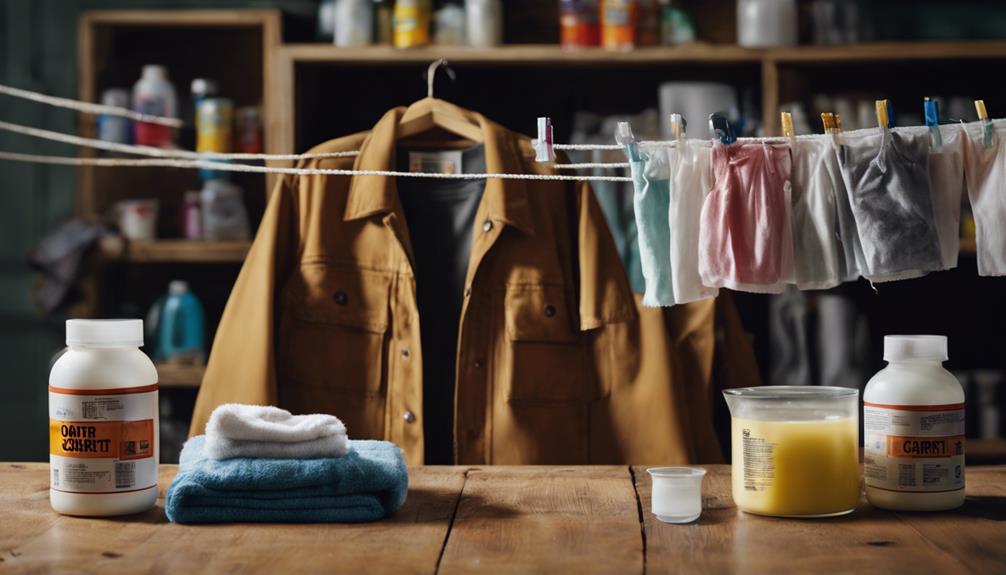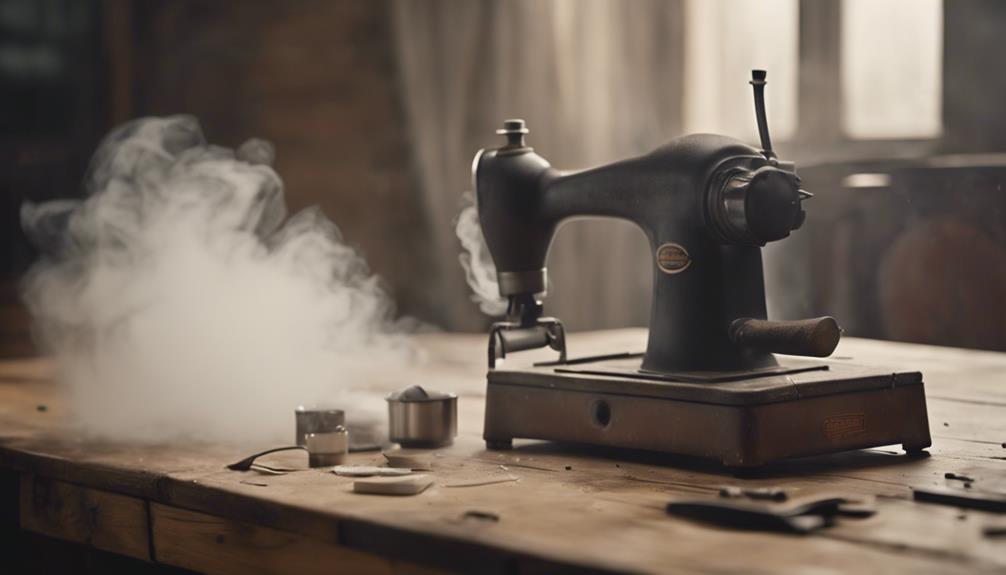When washing your Carhartt jacket, start by reviewing the care label and understanding the washing instructions. Set your washing machine to warm temperature and avoid overloading. Choose a gentle, eco-friendly detergent, avoiding harsh chemicals. Run a normal washing cycle with warm water and add detergent without bleach. For drying, consider air drying or tumble drying on medium temperature to prevent shrinkage. Iron your jacket inside out with a warm setting, following care label instructions. By following these steps, you'll be able to maintain your jacket's water-repellent properties and extend its lifespan. Continue to learn more about specialized care for your Carhartt jacket.
Key Takeaways
- Review the care label and understand washing instructions to ensure proper care of your Carhartt jacket.
- Choose a mild, eco-friendly detergent without harsh chemicals to prevent damage to the fabric.
- Set the washing machine to warm temperature and adjust the load capacity to prevent overloading.
- Avoid using fabric softeners and bleach to maintain the water-repellent properties of the jacket.
- Consider air drying or tumble drying on a medium setting to prevent shrinkage and damage to the fabric.
Before You Start Washing
Before you start washing your Carhartt jacket, take a minute to review the care label. It's crucial to understand the specific washing instructions to prevent damaging your jacket. Check the label for any special care requirements, as different fabrics may need unique attention.
When you're ready to wash, set your washing machine to a warm temperature below 160°F for best cleaning results. Make sure to use a detergent that's free of bleach and fabric softeners, as these can harm the fabric. Avoid overloading the washing machine, as this can cause poor cleaning and potentially damage your jacket.
Choosing the Right Detergent

When choosing a detergent for your Carhartt jacket, you'll want to select one that meets specific criteria to guarantee the jacket's quality is maintained.
You'll need to contemplate the type of detergent, whether eco-friendly options are available, and which harsh chemicals to avoid.
Detergent Type Matters
Your choice of detergent plays a critical role in maintaining the quality and performance of your Carhartt jacket. When it comes to washing your Carhartt jacket, using the right detergent type matters. You'll want to opt for a gentle detergent that's specifically designed for workwear like Carhartts.
Here are some key considerations to keep in mind:
- Avoid harsh chemicals: Steer clear of detergents that contain bleach or peroxide, as they can damage the fabric of your jacket.
- Say no to fabric softeners: These can leave a waxy coating that affects the performance of your jacket.
- Prioritize stain removal: Choose a detergent that's effective at removing tough stains without damaging the fabric.
- Opt for a mild detergent: Gentle detergents are best for washing Carhartt jackets.
- Read labels carefully: Always check the ingredient list to make certain the detergent is safe for your jacket's fabric.
Eco-Friendly Options Available
You can make a positive impact on the environment by choosing eco-friendly detergents specifically designed for washing your Carhartt jacket. Look for detergents labeled as biodegradable and plant-based, as they reduce environmental impact.
Opt for detergents free from phosphates, optical brighteners, and synthetic fragrances for a more sustainable option. Consider concentrated detergents to minimize packaging waste and reduce water usage during production.
Additionally, choose detergents with certifications like EPA Safer Choice or USDA Certified Biobased for a greener choice. Refillable detergent options or bulk purchasing can also reduce single-use plastic waste and promote sustainability.
Harsh Chemicals to Avoid
To guarantee the longevity of your Carhartt jacket, steer clear of harsh chemicals that can damage its fabric, and instead opt for a gentle detergent specifically designed for workwear. When it comes to washing your Carhartt jacket, it's crucial to avoid harsh chemicals that can compromise its performance and durability.
Here are some harsh chemicals to avoid:
- Bleach and peroxide: These can damage the fabric of your Carhartt jacket, causing it to deteriorate over time.
- Fabric softeners: These can leave a waxy coating on your jacket, affecting its performance and water-repellent properties.
- Harsh detergents: Avoid using detergents that contain harsh chemicals, as these can damage the fabric and reduce the jacket's lifespan.
- Optical brighteners: These can affect the color and fabric of your Carhartt jacket, causing it to fade or discolor over time.
- Chlorine: This can weaken the fabric of your jacket, making it more prone to tears and damage.
Remember to always wash your Carhartt jacket in cold water and choose a detergent that's specifically designed for workwear. By avoiding harsh chemicals and following the recommended washing instructions, you can make sure your Carhartt jacket remains in top condition for years to come.
Washing Machine Settings

Set the washing machine's water temperature to warm, below 160°F, to guarantee a gentle cleaning process for your Carhartt jacket. This warm water temperature ensures a thorough cleaning without damaging the fabric.
When setting up the washing machine, adjust the load capacity based on the number of coats you're washing – use a medium setting for one coat and large or extra-large for two coats.
Make sure to add detergent without bleach or peroxide to the washing machine, as these harsh chemicals can damage the fabric. It's also essential to avoid using fabric softeners, which can reduce the water repellency of your Carhartt jacket.
Run the washing machine on a normal cycle to clean the jacket effectively. This normal cycle washing will maintain the zipper quality and ensure your jacket looks its best after washing.
Adding Detergent and Softeners

When washing your Carhartt jacket, it's crucial to get the detergent and softeners right.
You'll want to choose a detergent without bleach or peroxide to prevent fabric damage, and measure it correctly to avoid over- or under-cleaning.
Additionally, you'll need to bear in mind avoiding fabric softeners altogether, as they can leave a residue that affects the jacket's performance and even its flame-resistant properties.
Choosing the Right Detergent
You'll want to choose a mild detergent specifically designed for washing workwear garments like your Carhartt jacket. This is important to make sure the fabric remains in good condition and the jacket continues to perform as expected.
Avoid using detergents that contain bleach or peroxide, as these can damage the fabric and compromise the jacket's integrity.
Here are some key considerations when selecting a detergent:
- Avoid harsh chemicals: Bleach and peroxide can damage the fabric, so opt for a gentle detergent instead.
- Skip fabric softeners: These can leave a waxy residue on the jacket, affecting its performance and appearance.
- Prioritize stain removal: Choose a detergent that's effective at removing stains without being too harsh on the fabric.
- Gentle yet effective: Select a detergent that's gentle on the fabric yet tough on stains and dirt.
- Quality matters: Opt for a reputable brand that specializes in workwear detergents to ensure the best results.
Measuring Detergent Correctly
To guarantee your Carhartt jacket gets the right clean, measure the detergent according to the jacket's size and your washing machine's load capacity. This ensures you're using the proper quantity of detergent for effective cleaning without residue buildup.
Using too little detergent can result in poor cleaning, while excessive detergent can leave residue that affects the jacket's quality. When adding detergent, make sure to choose a type that doesn't contain bleach or peroxide, as these can damage the fabric. Avoid using fabric softeners, as they can also harm the jacket's material.
Instead, follow the recommended amount of detergent for your washing machine's load capacity and the size of your Carhartt jacket. Proper detergent measurement is essential to maintain the jacket's quality and extend its lifespan.
Avoiding Fabric Softeners
Add detergent carefully, skipping fabric softeners altogether, as they can leave a waxy residue that compromises the performance of your Carhartt jacket. When you wash your Carhartt jacket, using a mild, gentle detergent is crucial to not damage the fabric.
Fabric softeners, on the other hand, can leave a residue that affects the jacket's water-repellent properties and overall performance.
Here are some key reasons to avoid fabric softeners when washing your Carhartt jacket:
- Fabric softeners can leave a waxy residue on your jacket, reducing its water-repellent properties.
- They can damage the fabric, leading to a shorter lifespan for your jacket.
- Fabric softeners can also reduce the breathability of your jacket, making it less comfortable to wear.
- Using fabric softeners can void your Carhartt jacket's warranty, so it's best to avoid them altogether.
- By skipping fabric softeners, you can guarantee your Carhartt jacket remains in top condition, wash after wash.
Running the Washing Cycle

Frequently, when washing a Carhartt jacket, you should set the washing machine water temperature to warm, below 160°F, in order to prevent damage to the fabric. This guarantees that the jacket's quality is maintained during the washing process.
Next, adjust the load capacity based on the number of coats being washed, such as medium for one coat or large for two coats. It's crucial to add detergent without bleach or peroxide to preserve the jacket's quality during washing.
Then, run the washing machine on a normal cycle to effectively clean the Carhartt jacket. Be sure to check the care label for any specific washing instructions.
After the wash cycle is complete, transfer the washed coat to the dryer and set it to a warm or medium temperature for drying. By following these steps, you'll be able to wash your Carhartt jacket with confidence, making sure it remains in excellent condition.
Drying Your Carhartt Jacket

Now that you've washed your Carhartt jacket, it's time to dry it.
You have two primary options: air drying or tumble drying, each with its own set of considerations.
As you decide which method to use, you'll want to weigh the benefits and potential drawbacks of each to make sure your jacket looks its best.
Air Dry Methods
When air drying your Carhartt jacket, hang it on a sturdy hanger or clothesline to allow it to dry naturally and evenly. This method is recommended to prevent potential shrinkage and maintain the fabric's integrity. By air drying, you'll guarantee your jacket retains its quality and fits comfortably.
To secure a successful air drying process, keep the following tips in mind:
Avoid direct sunlight or high heat sources to prevent damage to the material.
Ensure proper ventilation in the drying area for efficient air circulation and drying.
Check the jacket periodically to maintain its shape and quality.
Don't hang the jacket in a cramped space, as this can cause wrinkles and creases.
Allow the jacket to dry completely before storing or wearing it again.
Tumble Dry Settings
To guarantee damage prevention and shrinking avoidance, you should tumble dry your Carhartt jacket on a medium setting. This will help maintain the thermal protective properties of the fabric and prevent overheating.
When tumble drying, it's crucial to remove the jacket promptly to avoid wrinkles and creases. You can also opt to tumble dry low or dry with no heat to make certain the fabric remains intact.
Additionally, avoid using fabric softener, as it can reduce the water-repellent properties of the jacket. Before drying, make sure to completely close all zippers, including the slim slider pull-tabs, to prevent any damage.
Always follow the care label instructions for specific tumble dry recommendations for your Carhartt jacket. Properly drying your Carhartt jacket can help prolong its lifespan and preserve its appearance.
Ironing and Finishing Touches

You'll want to iron your Carhartt jacket inside out to prevent damage to the fabric and achieve a crisp, smooth finish.
When ironing, use a warm iron setting to smooth out any wrinkles or creases on the jacket. Be sure to check the care label for specific ironing instructions, as some fabrics may require special care.
- Iron with low heat to prevent scorching or melting of fabrics.
- Use an appropriate ironing temperature to avoid damaging the fabric.
- Finish with touch-up ironing if needed before wearing.
- Avoid ironing over zippers or embellishments to prevent melting or distortion.
- Always follow specific ironing instructions on the care label to secure the best results.
Alternative Dry Cleaning Option

While ironing can work wonders for your Carhartt jacket, there's an alternative method that's just as effective, if not more so, for certain types of jackets: dry cleaning. This professional cleaning method is ideal for jackets made from delicate materials or featuring intricate designs that may not withstand regular washing.
Dry cleaning effectively removes stains and odors without risking damage to the garment, making it a great option for maintaining your jacket's quality and appearance. By opting for dry cleaning, you can prolong the lifespan of your Carhartt jacket by preventing shrinkage or fabric distortion.
This is especially important for specialized fabrics like flame-resistant materials, which require extra care to maintain their performance. By entrusting your jacket to a professional dry cleaner, you can be confident that it receives the specialized care it needs to stay in top condition.
With dry cleaning, you can rest assured that your Carhartt jacket will continue to perform at its best, wash after wash.
Special Care for Flame-Resistant Fabrics

When working with flame-resistant fabrics, it's imperative to follow specific laundering instructions to maintain their thermal protective properties. You can't afford to compromise on the safety features of your Carhartt jacket, so pay attention to the care label.
Here are some important tips to keep in mind:
- Machine wash warm to prevent damage to the fabric.
- Avoid using bleach and softeners, as they can reduce the fabric's flame-resistance.
- Tumble dry low to prevent shrinkage and damage.
- Iron with low heat to prevent scorching or melting of the fabric.
- Consider dry cleaning options for certain flame-resistant garments, and always check the care label before proceeding.
Extending the Life of Your Jacket

To extend the life of your Carhartt jacket, follow the specific care instructions on the label and take a few simple precautions to prevent damage. Washing your jacket in warm water without bleach and tumble drying at a medium setting helps maintain its quality. Be sure to avoid using fabric softeners, as they can damage the fabric.
Proper zipper care is also essential – avoid yanking or forcing the zipper, and clean it regularly to prevent rust. When storing your jacket, keep it away from direct sunlight and moisture to prevent fading and mildew. Regularly inspect your jacket for signs of wear and tear, such as fraying, tears, or fading, and address them promptly to prevent further damage.
Frequently Asked Questions
Can You Put a Carhartt Jacket in the Washer?
You're wondering if you can put your Carhartt jacket in the washer, and the answer is yes, you can, but be sure to follow the specific washing instructions provided by Carhartt to keep it in top condition.
Does Carhartt Shrink When Washed?
You might wonder, does Carhartt shrink when washed? Rest assured, Carhartt jackets are designed to withstand washing with minimal shrinkage, thanks to pre-shrunk durable materials, so you can wash with confidence.
Will Washing a Carhartt Jacket Make It Softer?
You'll be happy to know that washing your Carhartt jacket can actually make it softer over time, breaking down the initial stiffness from manufacturing.
How to Wash a Canvas Work Jacket?
"Did you know 70% of people ruin their jackets by washing them incorrectly? You're about to join the 30% who do it right! To wash your canvas work jacket, use cold water, skip bleach, and tumble dry on medium – your jacket will thank you!"
Can Properly Washing a Carhartt Jacket Reflect Modern Vernacular Ideals?
Properly washing a Carhartt jacket is essential for maintaining its durability and quality. By exploring modern vernacular insights, one can see the importance of taking care of belongings to reflect contemporary values. This act reflects the modern ideals of sustainability and responsibility towards the products we own.
Conclusion
As you hang your freshly washed Carhartt jacket on the line, the sun shines bright, much like the armor of a medieval knight, protecting it from the elements.
By following these guidelines, you've guaranteed your trusty companion will remain a faithful protector for many adventures to come.
Remember, a well-cared-for jacket is a long-lasting one, and with these simple steps, you've secured a victorious battle against wear and tear.










